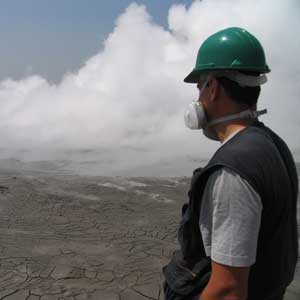|
News Notes
Natural Hazards
Mudflows inundate Indonesian villages
 Since May, a torrent of gassy, smelly hot mud has been vigorously erupting in Indonesia. So far, mud reportedly has submerged more than a half-dozen villages, 20 factories, and hundreds of acres of rice paddies and farmland. And geologists studying the anomalous mudflow say there’s no end in sight.
Since May, a torrent of gassy, smelly hot mud has been vigorously erupting in Indonesia. So far, mud reportedly has submerged more than a half-dozen villages, 20 factories, and hundreds of acres of rice paddies and farmland. And geologists studying the anomalous mudflow say there’s no end in sight.
A team of geologists recently traveled to Indonesia to examine a mudflow that has buried several villages, and to try to determine what caused the sudden eruption. From May through the beginning of October, the mudflow covered more than 4 square kilometers, and has shown no signs of waning. Photograph is by Adriano Mazzini.
Since May 29, a virtual lake of mud has covered more than 400 hectares of the Indonesian countryside outside Surabaya, the country’s second-largest city, says Adriano Mazzini, a geologist at the University of Oslo in Norway, who spent 10 days at the site in September. When it began, the mudflow spewed about 5,000 cubic meters of mud a day; in September, it was erupting more than 100,000 cubic meters of mud per day, Mazzini says. More than 10,000 people have been forced from their homes, which are now buried in mud up to 5 meters deep.
What caused the mudflow, however, is unknown, says Giuseppe Etiope, a geologist at the National Institute of Geophysics and Volcanology in Rome, Italy. It may be a mudflow released from a buried, abandoned oil well, he says. Or, Mazzini says, it may be the birth of a new mud volcano — an eruption related to the production, accumulation and migration of natural gas that occurs because of a sudden release of pressure. The characteristics of this mudflow, however, “are not typical of a mud volcano, as it is too fluid, too warm and unusually long lasting,” Etiope says. But mud volcanoes are fairly common in Indonesia: The country has more than 100 mostly dormant mud volcanoes.
“It is not possible” to determine the cause of the mudflow yet, Etiope says, and may not ever be. “We have no detailed information on local deep geology and the characteristics of the [gas] exploration well,” he says. Several possibilities are being explored, however.
One leading suggestion is that a gas company that had been drilling an exploration well about 150 meters from the mud crater depressurized the system, causing the eruption. Another possibility is that magmatic volcanic activity nearby could have pushed hydrothermal fluids into the area and caused the mud eruption, Mazzini says.
Yet another idea is that a magnitude-4 earthquake that occurred in the area two days before the mudflow erupted cracked the rocks above the flow and released the overpressure, Mazzini says. Earthquakes have been associated with eruptions in the past, Etiope says, but not always — many earthquakes have occurred near mud volcanoes without “perturbing” them and triggering eruptions.
To learn more about the subsurface and the actual mud eruption, Mazzini’s team collected samples of gas, water and mud at the site. Such information could help researchers determine if the eruption is natural, which may help determine how long it will continue erupting, Mazzini says.
With many people blaming the gas company Lapindo Brantas, the company has been footing much of the cleanup bill, as well as helping out the refugees — to the tune of $75 million by the beginning of October, according to The Economist on Oct. 5. Lapindo Brantas is handling the situation professionally, Mazzini says, trying to help figure out the cause of the catastrophe and how to stop it.
Meanwhile, the Indonesian government has stepped in to try to solve the issue. The government has given permission to villagers to dig canals and build dikes to try to divert the mudflows into a local river that flows 15 kilometers out to sea. But some environmental groups are concerned about the potential hazards of the gas-rich mud being dumped into the river and then the ocean, as well as about the mud damming up the river and causing further damages during the rainy season, which began in October. Other efforts by the government and the gas company include trying to relieve the pressure by drilling relief wells, and pouring concrete into the crater to cap the mudflow — to no avail so far, Mazzini says.
Stopping the flow of a mud volcano has never been successful elsewhere, Mazzini says, so he is skeptical it can work in Indonesia. Instead, he suggests that the local people try to work around it, or even use the power of the mud — perhaps by turning it into a spa or a geothermal energy source, or by forming the mud into bricks and selling them.
Megan Sever

 Subscribe
Subscribe

